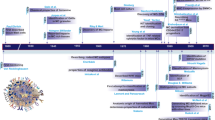Summary
The proliferation of rat peritoneal mast cells was examined under normal conditions in vivo. DNA content of individual mast cells was measured by cytofluorometry after staining with the bibenzimidazole dye Hoechst 33258. Diploid non mast cells from each rat were used as a biological standard, which resulted in small long-term variations in the method. The proportion of mast cells in the S+G2 region of the DNA distribution was about 4% for young rats (24 days old, body-weights about 60 g). It decreased in relation to body-weight, and was less than 1% for 105-day-old rats weighing 400 g. During the same growth period the total number of mast cells in the peritoneal cavity increased about 8-fold. The total number of proliferating cells, about 30,000, remained constant throughout the observation period. No evidence of polyploidization or accumulation in G2 of mast cell nuclei was found. It is concluded that peritoneal mast cells increase in number by mitotic proliferation of differentiated cells.
Similar content being viewed by others
References
Allen AM (1962) Mitosis and binucleation in mast cells of the rat. J Nat Canc Inst 28:1125–1151
Blenkinsopp WK (1967) Mast cell proliferation in adult rats. J Cell Sci 2:33–37
Böhm N, Sprenger E (1968) Fluorescent cytophotometry: a valuable method for the quantitative determination of nuclear Feulgen-DNA. Histochemie 16:100–118
Cowell JK, Franks LM (1980) A rapid method for accurate DNA measurements in single cells in situ using a simple microfluorimeter and Hoechst 33258 as a quantitative fluorochrome. J Histochem Cytochem 28:206–210
Enerbäck L (1974) Berberine sulphate binding to mast cell polyanions: a cytofluorometric method for the quantitation of heparin. Histochemistry 42:301–313
Enerbäck L, Mellblom L (1978) 5-hydroxytryptamine content of mast cells, mast cell numbers and body growth. Exp Cell Res 112:103–109
Gledhill BL, Lake S, Steinmetz LL, Gray JW, Crawford JR, Dean PN, Van Dilla MA (1975) Flow microfluorometric analysis of sperm DNA content: Effects of cell shape on the fluorescence distribution. J Cell Physiol 87:367–376
Hilwig I, Gropp A (1972) Staining of constitutive heterochromatin in mammalian chromosomes with a new fluorochrome. Exp Cell Res 75:122–126
Hilwig I, Gropp A (1973) Decondensation of constitutive heterochromatin in L cell chromosomes by a benzimidazole compound (“33258 Hoechst”). Exp Cell Res 81:474–477
Hunt TE, Hunt EA (1957) Mitotic activity of mast cells. Proc Soc Exp Biol Med 94:166–169
Johannisson E, Thorell B (1977) Mithramycin fluorescence for quantiative determination of deoxyribonucleic acid in single cells. J Histochen Cytochem 25:122–128
Kiernan JA (1979) Production and life span of cutaneous mast cells in young rats. J Anat 128:225–238
Latt SA (1973) Microfluorometric detection of deoxyribonucleic acid replication in human metaphase chromosomes. Proc Natl Acad Sci USA 70:3395–3399
Latt SA, Wohlleb JC (1975) Optical studies of the interaction of 33258 Hoechst with DNA, chromatin and metaphase chromosomes. Chromosoma 52:297–316
Le Pecq J-B, Paoletti C (1967) A fluorescent complex between ethidium bromide and nucleic acids. Physical-Chemical characterization. J Mol Biol 27:87–106
Mellblom L (1979) Growth-related changes of connective tissue mast cells. A quantitative cytofluorometric and microinterferometric study. Linköping University Medical Dissertations No 82
Mellblom L, Enerbäck L (1979) Protein content, dry mass and chemical composition of individual mast cells related to body growth. Histochemistry 63:129–143
Müller W, Gautier F (1975) Interactions of heteroaromatic compounds with nucleic acids. AT-specific non-intercalating DNA ligands. Eur J Biochem 54:385–394
Padawer J (1973) The peritoneal cavity as a site for studying cell-cell and cell-virus interactions. RES-J Reticuloendothel Soc 14:462–512
Padawer J (1974) Mast cells: extended lifespan and lack of granule turnover under normal in vivo conditions. Exp Mol Pathol 20:269–280
Padawer J, Gordon AS (1956) Peritoneal fluid mast cells: their numbers and morphology in rats of various body weights (ages). J Gerontol 11:268–272
Rigler R (1966) Microfluorometric characterization of intracellular nucleic acids and nucleoproteins by acridine orange. Acta Physiol Scand Suppl 267
Ruch F (1973) Quantitative determination of DNA and protein in single cells. In: Thaer AA, Sernetz M (eds) Fluorescence techniques in cell biology. Springer, Berlin Heidelberg New York, pp 89–93
Teorell T, Stenhagen E (1938) Ein Universalpuffer für den pH-Bereich 2.0 bis 12.0. Biochem Z 299:416–419
Walker BE (1961) Mast cell turnover in adult mice. Nature 192:980–981
Weisblum B, Haenssler E (1974) Pluorometric properties of the bibenzimidazole derivative Hoechst 33258, a fluorescent probe specific for AT concentration in chromosomal DNA. Chromosoma 46:255–260
Yong LC (1980) A combined histochemical and autoradiographic study of the distribution and maturation of peritoneal mast cells in the rat. Experientia 36:451–452
Zante J, Schumann J, Göhde W, Hacker U (1977) DNA-fluorometry of mammalian sperm. Histochemistry 54:1–7
Author information
Authors and Affiliations
Additional information
Supported by grants from the Swedish Medical Research Council, Project No. 2235
Rights and permissions
About this article
Cite this article
Enerbäck, L., Rundquist, I. DNA distribution of mast cell populations in growing rats. Histochemistry 71, 521–531 (1981). https://doi.org/10.1007/BF00508378
Received:
Issue Date:
DOI: https://doi.org/10.1007/BF00508378




